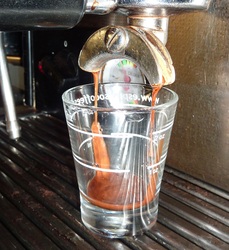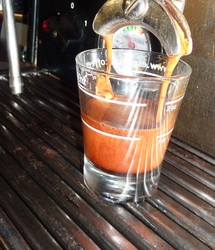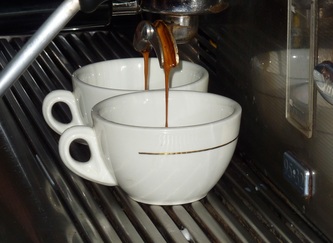One of the first things people realise when learning to make coffee is the number of variables which affect the coffee quality. This post will explain what, for many people is the most important variable, master this and you will be creating better coffee than most cafes.
Some of the variables which affect your coffee are:
Some of the variables which affect your coffee are:
- The quality of the beans
- The roast and blend
- The machinery (maintained machine, and grinder)
- The temperature of the machines heads at the time of extraction
- The coarseness of the grind
- The extraction cut off point
The grind coarseness
The coarseness of the grind should be the only factor which affects how fast or slow the coffee extracts through the handle (tamp pressure is always the same). Ground coffee contains a wide range of flavours, from the sweet, aromatic to the hideously bitter.
Adjusting the grind even minutely will affect the extraction rate and have a great impact on what flavours you are able to enjoy or have to endure.
It is the controlling of the extraction rate (i.e the grind coarseness) which depicts what flavours will end up in the cup.
So go ahead, play with the adjustment on your grinder between the fine and course settings. Depending on the grinder, a small adjustment will affect the extraction flow considerably.
Hopefully with a few importance of getting the grind right and your grinder won't be one of the ones I see regularly with a sign stating 'do NOT adjust the grind', because it should be compulsory! Enjoy...
Adrian
What are your thoughts on the correct extraction rate? Let us know in the comments below.
Adjusting the grind even minutely will affect the extraction rate and have a great impact on what flavours you are able to enjoy or have to endure.
It is the controlling of the extraction rate (i.e the grind coarseness) which depicts what flavours will end up in the cup.
- If it extracts too fast (grind too coarse), there is not enough time for the hot, pressurised water to extract the sweet, desirable flavours, leaving you with a weak, poor tasting coffee.
- If it extracts too slow (grind too fine) the hot, pressurised water takes so long to get through the grinds that it ends up burning the coffee on the way through leaving the drinker with a bitter taste in their mouth that will last for up to an hour.
So go ahead, play with the adjustment on your grinder between the fine and course settings. Depending on the grinder, a small adjustment will affect the extraction flow considerably.
Hopefully with a few importance of getting the grind right and your grinder won't be one of the ones I see regularly with a sign stating 'do NOT adjust the grind', because it should be compulsory! Enjoy...
Adrian
What are your thoughts on the correct extraction rate? Let us know in the comments below.



 RSS Feed
RSS Feed